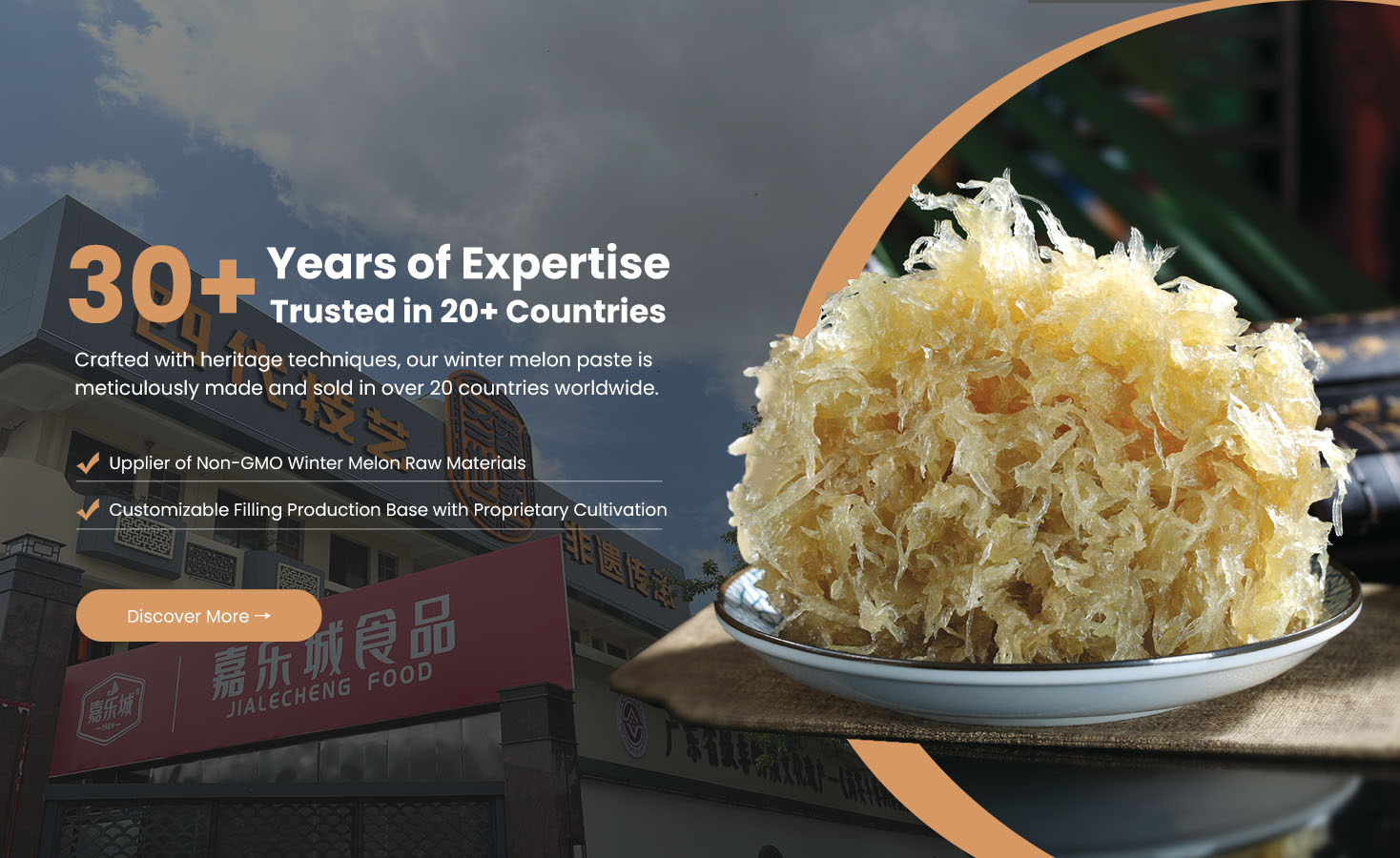What Is Winter Melon Paste And How Is It Made?
winter melon paste (also called white gourd paste or Winter Melon Filling) is a smooth, sweet, and translucent confection made from winter melon (also known as ash gourd). It’s widely used as a traditional filling in Chinese pastries, particularly mooncakes, wife cakes, and other bakery desserts. The paste has a mild, honeyed flavor and glossy texture that pairs well with ingredients like sesame, lotus seed, or coconut.
Companies like Jialecheng Foods specialize in producing large-scale winter melon paste for bakeries and OEM/ODM dessert manufacturers.
1. What Is Winter Melon?
Winter melon (Benincasa hispida) is a gourd native to Asia. When mature, it has a green outer skin and white, spongy flesh that becomes translucent when cooked. It’s naturally low in sugar and high in water content, making it ideal for sweet paste production after concentration and cooking.
| Property | Description |
|---|---|
| Scientific Name | Benincasa hispida |
| Common Names | Winter melon, white gourd, ash gourd |
| Texture | Firm, watery flesh that softens when cooked |
| Flavor | Mild and slightly grassy; absorbs added sugar and flavor easily |
2. What Is Winter Melon Paste Used For?
Winter melon paste is primarily used as a filling for baked and steamed pastries, giving a smooth, chewy consistency and gentle sweetness.
Common Uses:
Mooncakes (especially traditional Cantonese-style)
Wife cakes (Sweetheart cakes)
Crispy pastry rolls and biscuits
Bakery fillings for buns, breads, or cookies
Customized fillings with flavors like pineapple, mango, or red bean
Because it holds its shape when baked, winter melon paste is an excellent base for both traditional and modern desserts.
3. How Winter Melon Paste Is Made
The production process transforms fresh winter melon into a thick, smooth paste through cooking, evaporation, and flavor infusion.
Step 1: Selection and Cleaning
Fresh, mature winter melons are selected for their firmness and sweetness. The outer rind and seeds are removed, leaving only the white flesh.
Step 2: Cutting and Blanching
The flesh is cut into small cubes or slices and blanched in boiling water to soften the texture and remove excess bitterness.
Step 3: Cooking and Concentration
The melon is simmered in large pots or industrial kettles. Sugar is added gradually, sometimes along with maltose syrup to improve gloss and texture. The mixture is stirred continuously until it thickens and turns semi-translucent.
| Ingredient | Function |
|---|---|
| Winter melon flesh | Main ingredient |
| Sugar or maltose | Sweetness and preservation |
| Oil or shortening | Smoothness and mouthfeel |
| Water | Assists in cooking and dissolving sugars |
Step 4: Grinding and Refining
The cooked mixture is finely ground or blended to achieve a smooth texture. For large-scale production (like at Jialecheng Foods), vacuum evaporators are used to control moisture levels and achieve consistent paste density.
Step 5: Cooling and Packaging
Once the desired texture and sweetness are reached, the paste is cooled and packed into vacuum-sealed bags or tubs for bakery use.
4. Variations of Winter Melon Paste
Modern pastry manufacturers produce flavored versions of winter melon paste to suit different recipes:
Coconut winter melon paste – with desiccated coconut for tropical aroma.
Mango or pineapple paste – blended with fruit puree for tangy flavor.
Sesame or green tea paste – with added roasted seeds or matcha.
Low-sugar versions – for health-conscious bakery products.
Each variation maintains the smooth, glossy texture but introduces new flavor profiles for contemporary dessert markets.
5. Characteristics of High-Quality Winter Melon Paste
| Feature | Description |
|---|---|
| Color | Light amber to translucent golden |
| Texture | Smooth, pliable, not sticky |
| Sweetness | Balanced, not overly sugary |
| Aroma | Mild, natural melon scent |
| Stability | Retains shape when baked or stored |
| Shelf Life | 6–12 months (when vacuum-packed) |
High-quality paste should have a fine texture, even color, and resistance to oil separation during baking.
6. Why Manufacturers Like Jialecheng Use Winter Melon
Abundant supply – locally grown in Guangdong and Guangxi regions.
Stable production – high yield per acre for consistent raw material sourcing.
Versatile ingredient – acts as a neutral base for many fillings.
Export-friendly – long shelf life and easy storage under ambient conditions.
With more than 30 years of experience, Jialecheng Foods standardizes this process for OEM clients, ensuring consistency in taste, sweetness, and texture for industrial bakery use.
7. Conclusion
Winter melon paste is a classic East Asian pastry filling made by cooking and sweetening winter melon until it becomes a rich, smooth paste. Its delicate flavor and glossy appearance make it ideal for mooncakes, pastries, and modern desserts. Today, large producers like Jialecheng Foods have refined traditional methods with advanced equipment and strict quality control—delivering consistent, export-grade winter melon paste to bakeries and food manufacturers worldwide.




